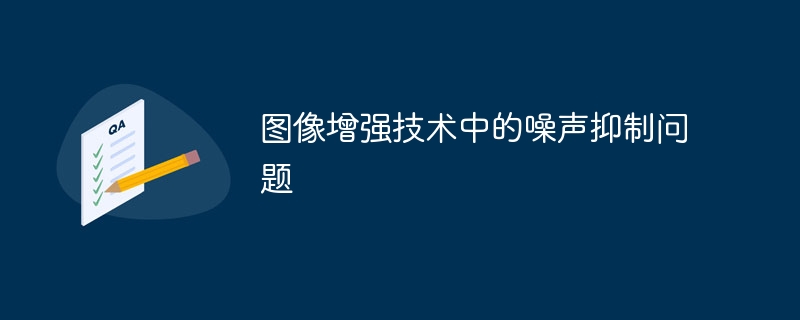Home >Technology peripherals >AI >Noise suppression issues in image enhancement technology
Noise suppression issues in image enhancement technology
- WBOYWBOYWBOYWBOYWBOYWBOYWBOYWBOYWBOYWBOYWBOYWBOYWBOriginal
- 2023-10-09 12:19:44725browse

Image enhancement is an important technology in digital image processing, which aims to improve the quality and details of images. However, in practical applications, images may be contaminated by various types of noise, such as Gaussian noise, salt-and-pepper noise, and speckle noise. These noises can reduce the visual effect and readability of images, so noise suppression is a key task in image enhancement.
The noise suppression problem in image enhancement technology can be solved through some effective methods. This article will introduce some common noise suppression techniques and provide corresponding code examples.
- Mean filter
Mean filter is a simple and commonly used noise suppression method. It is based on a fixed-size sliding window, calculates the average gray value of pixels within the sliding window, and uses this value as the filtered pixel value. The following is an example of a mean filter function based on Python:
import numpy as np
import cv2
def mean_filter(img, kernel_size):
width, height = img.shape[:2]
output = np.zeros_like(img)
pad = kernel_size // 2
img_pad = cv2.copyMakeBorder(img, pad, pad, pad, pad, cv2.BORDER_REFLECT)
for i in range(pad, width + pad):
for j in range(pad, height + pad):
output[i - pad, j - pad] = np.mean(img_pad[i - pad:i + pad + 1, j - pad:j + pad + 1])
return output
# 调用示例
image = cv2.imread('input.jpg', 0)
output = mean_filter(image, 3)
cv2.imwrite('output.jpg', output)- Median filter
Median filter is a nonlinear noise suppression method based on a fixed-size sliding Window, calculate the median value of pixels within the sliding window, and use this value as the filtered pixel value. The following is an example of a median filter function based on Python:
import numpy as np
import cv2
def median_filter(img, kernel_size):
width, height = img.shape[:2]
output = np.zeros_like(img)
pad = kernel_size // 2
img_pad = cv2.copyMakeBorder(img, pad, pad, pad, pad, cv2.BORDER_REFLECT)
for i in range(pad, width + pad):
for j in range(pad, height + pad):
output[i - pad, j - pad] = np.median(img_pad[i - pad:i + pad + 1, j - pad:j + pad + 1])
return output
# 调用示例
image = cv2.imread('input.jpg', 0)
output = median_filter(image, 3)
cv2.imwrite('output.jpg', output)- Bilateral filtering
Bilateral filtering is a filtering method that suppresses noise while maintaining image edge details. It calculates filter coefficients based on the spatial distance and gray value similarity of pixels, thereby suppressing noise while maintaining edge sharpness. The following is an example of a bilateral filtering function based on Python:
import numpy as np
import cv2
def bilateral_filter(img, sigma_spatial, sigma_range):
output = cv2.bilateralFilter(img, -1, sigma_spatial, sigma_range)
return output
# 调用示例
image = cv2.imread('input.jpg', 0)
output = bilateral_filter(image, 5, 50)
cv2.imwrite('output.jpg', output)Through the above example code, it can be seen that mean filtering, median filtering and bilateral filtering are all commonly used for noise suppression in image enhancement techniques. method. According to the actual situation and needs of the image, choosing the appropriate technology and parameters can effectively improve the quality and details of the image.
However, it should be noted that the selection and parameter settings of noise suppression methods are not static. Different types of noise and different images may require different processing methods. Therefore, in practical applications, it is very important to select appropriate noise suppression methods and parameters according to the characteristics and needs of the image.
The above is the detailed content of Noise suppression issues in image enhancement technology. For more information, please follow other related articles on the PHP Chinese website!

